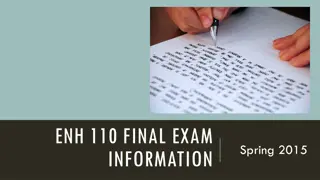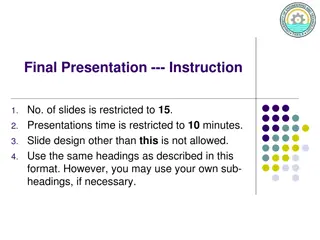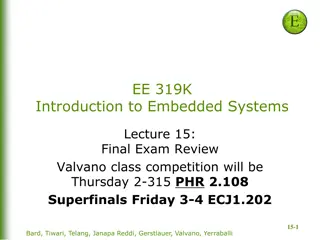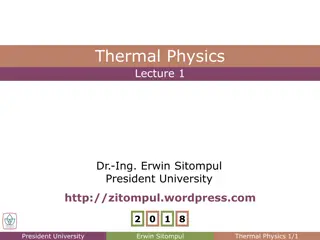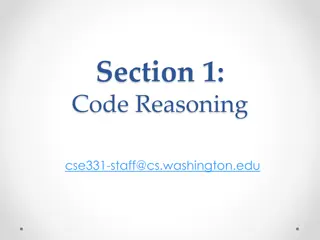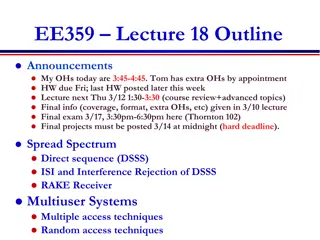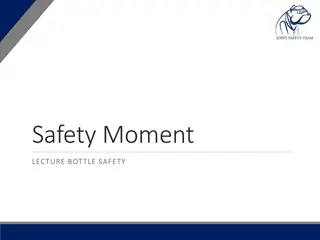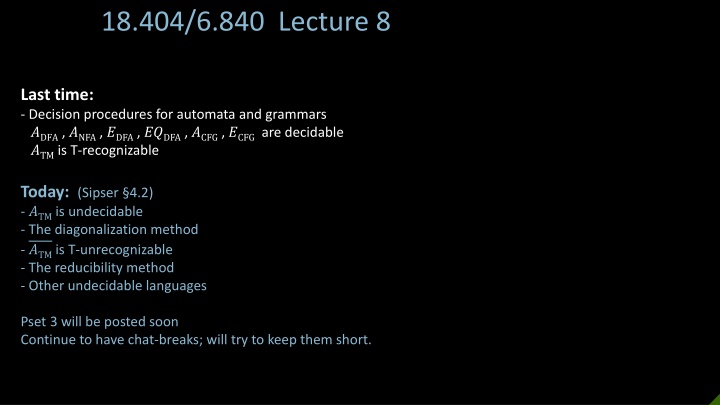
Comparing Infinite Sets: Diagonalization Method Explained
Explore decision procedures for automata, undecidability of TMs, and comparison of infinite sets using Cantor's ideas. Learn about countable and uncountable sets and how diagonalization proves the uncountability of real numbers. Discover the implications for mathematics and the interpretation of unsolvable questions.
Download Presentation

Please find below an Image/Link to download the presentation.
The content on the website is provided AS IS for your information and personal use only. It may not be sold, licensed, or shared on other websites without obtaining consent from the author. If you encounter any issues during the download, it is possible that the publisher has removed the file from their server.
You are allowed to download the files provided on this website for personal or commercial use, subject to the condition that they are used lawfully. All files are the property of their respective owners.
The content on the website is provided AS IS for your information and personal use only. It may not be sold, licensed, or shared on other websites without obtaining consent from the author.
E N D
Presentation Transcript
18.404/6.840 Lecture 8 Last time: - Decision procedures for automata and grammars ?DFA , ?NFA , ?DFA , ??DFA , ?CFG , ?CFG are decidable ?TM is T-recognizable Today: (Sipser 4.2) - ?TM is undecidable - The diagonalization method - ?TM is T-unrecognizable - The reducibility method - Other undecidable languages Pset 3 will be posted soon Continue to have chat-breaks; will try to keep them short.
Recall: Acceptance Problem for TMs Let ?TM = { ?,? | ? is a TM and ? accepts ?} Today s Theorem: ?TMis not decidable Proof uses the diagonalization method, so we will introduce that first.
The Size of Infinity How to compare the relative sizes of infinite sets? Cantor (~1890s) had the following idea. Defn: Say that set ? and ? have the same size if there is a one-to-one and onto function ?:? ? ? ? ? ? ? ? injective Range (?) = ? surjective We call such an ? a 1-1 correspondence Informally, two sets have the same size if we can pair up their members. This definition works for finite sets. Apply it to infinite sets too. ?:
Countable Sets Let = {1,2,3, } and let = { , 2, 1,0,1,2, } Show and have the same size ? ?(?) 1 0 2 -1 Let += ?? ?,? } 3 1 4 -2 Show and + have the same size 5 2 ? ?(?) 6 -3 + 1 2 3 4 1 1/1 7 3 + 2 2/1 1 1/1 1/2 1/3 1/4 3 1/2 2 2/1 2/2 2/3 2/4 4 3/1 3 3/1 3/2 3/3 3/4 Defn: A set is countable if it is finite or it has the same size as . 5 3/2 4 4/1 4/2 4/3 4/4 6 2/3 7 1/3 Both and + are countable.
is Uncountable Diagonalization Let = all real numbers (expressible by infinite decimal expansion) Theorem: is uncountable Proof by contradiction via diagonalization: Assume is countable So there is a 1-1 correspondence ?: ? 1 2 3 4 5 6 7 ?(?) Demonstrate a number ? that is missing from the list. 2.718281828 3.141592653 0.000000000 1.414213562 0.142857242 0.207879576 1.234567890 7 4 ? =0.8516182 0 2 differs from the ?th number in the ?th digit so cannot be the ?th number for any ?. Hence ? is not paired with any ?. It is missing from the list. Therefore ? is not a 1-1 correspondence. 5 9 8 Diagonalization
is Uncountable Corollaries Let = all languages Corollary 1: is uncountable Proof: There s a 1-1 correspondence from to so they are the same size. Observation: = {?,0,1,00,01,10,11,000, } is countable. Check-in 8.1 Hilbert s 1st question asked if there is a set of intermediate size between and . G del and Cohen showed that we cannot answer this question by using the standard axioms of mathematics. How can we interpret their conclusion? (a) We need better axioms to describe reality. (b) Infinite sets have no mathematical reality so Hilbert s 1st question has no answer. { ?, 0, 1, 00, 01, 10, 11, 000, Let = all Turing machines Observation: is countable. Because ? ? is a TM} . ? { 0, 00, 01, ? ? .0 1 0 1 1 0 0 0 Corollary 2: Some language is not decidable. Because there are more languages than TMs. We will show some specific language ?TM is not decidable. Check-in 8.1
?TM is undecidable Recall ?TM = { ?,? | ? is a TM and ? accepts ?} Theorem: ?TMis not decidable Proof by contradiction: Assume some TM ? decides ?TM. So ? on ?,? = Accept if ? accepts ? Reject Why is this proof a diagonalization? if not All TMs All TM descriptions: Use ? to construct TM ? ? = On input ? 1. Simulate ? on input ?, ? 2. Accept if ? rejects. Reject if ?accepts. ?1 ?2 ?3 ?4 ? . . . ?1 acc acc rej acc acc . . . ?2 rej rej rej rej rej ? accepts ? iff ?doesn t accept ? . ? accepts ? iff ?doesn t accept ? . Contradiction. ?3 acc acc acc acc acc . . . ?4 rej rej acc acc acc ? rej acc rej rej ?
Check-in 8.2 Recall the Queue Automaton (QA) defined in Pset 2. It is similar to a PDA except that it is deterministic and it has a queue instead of a stack. Let ?QA= { ?,? | ? is a QA and ? accepts ?} Is ?QA decidable? (a) Yes, because QA are similar to PDA and ?PDA is decidable. (b) No, because yes would contradict results we now know. (c) We don t have enough information to answer this question. Check-in 8.2
?TM is T-unrecognizable Theorem: If ? and ? are T-recognizable then ? is decidable Proof: Let TM ?1 and ?2 recognize ? and ?. Construct TM ? deciding ?. ? = On input ? 1. Run ?1 and ?2 on ? in parallel until one accepts. 2. If ?1 accepts then accept. If ?2 accepts then reject. Check-in 8.3 Complement of T-recognizable = co-T-recognizable From what we ve learned, which closure properties can we prove for the class of T-recognizable languages? Choose all that apply. T-recognizable ?TM ?TM Corollary: ?TM is T-unrecognizable Proof: ?TM is T-recognizable but also undecidable (a) Closed under union. (b) Closed under intersection. (c) Closed under complement. (d) Closed under concatenation. (e) Closed under star. decidable Check-in 8.3
The Reducibility Method Use our knowledge that ?TM is undecidable to show other problems are undecidable. Defn: ????TM= ?,? ? halts on input ?} Theorem: ????TM is undecidable Proof by contradiction, showing that ?TM is reducible to ????TM: Assume that ????TM is decidable and show that ?TM is decidable (false!). Let TM ? decide ????TM. Construct TM ? deciding ?TM. ? = On input ?,? 1. Use ? to test if ? on ? halts. If not, reject. 2. Simulate ? on ? until it halts (as guaranteed by ?). 3. If ? has accepted then accept. If ? has rejected then reject. TM ? decides ?TM, a contradiction. Therefore ????TM is undecidable.
Quick review of today Showed that and are not the same size to introduce the Diagonalization Method. 1. 2. ?TMis undecidable. 3. If ? and ? are T-recognizable then ? is decidable. ?TM is T-unrecognizable. 4. 5. Introduced the Reducibility Method to show that ????TMis undecidable.






